Quick filters:
16th century german axe Stock Photos and Images
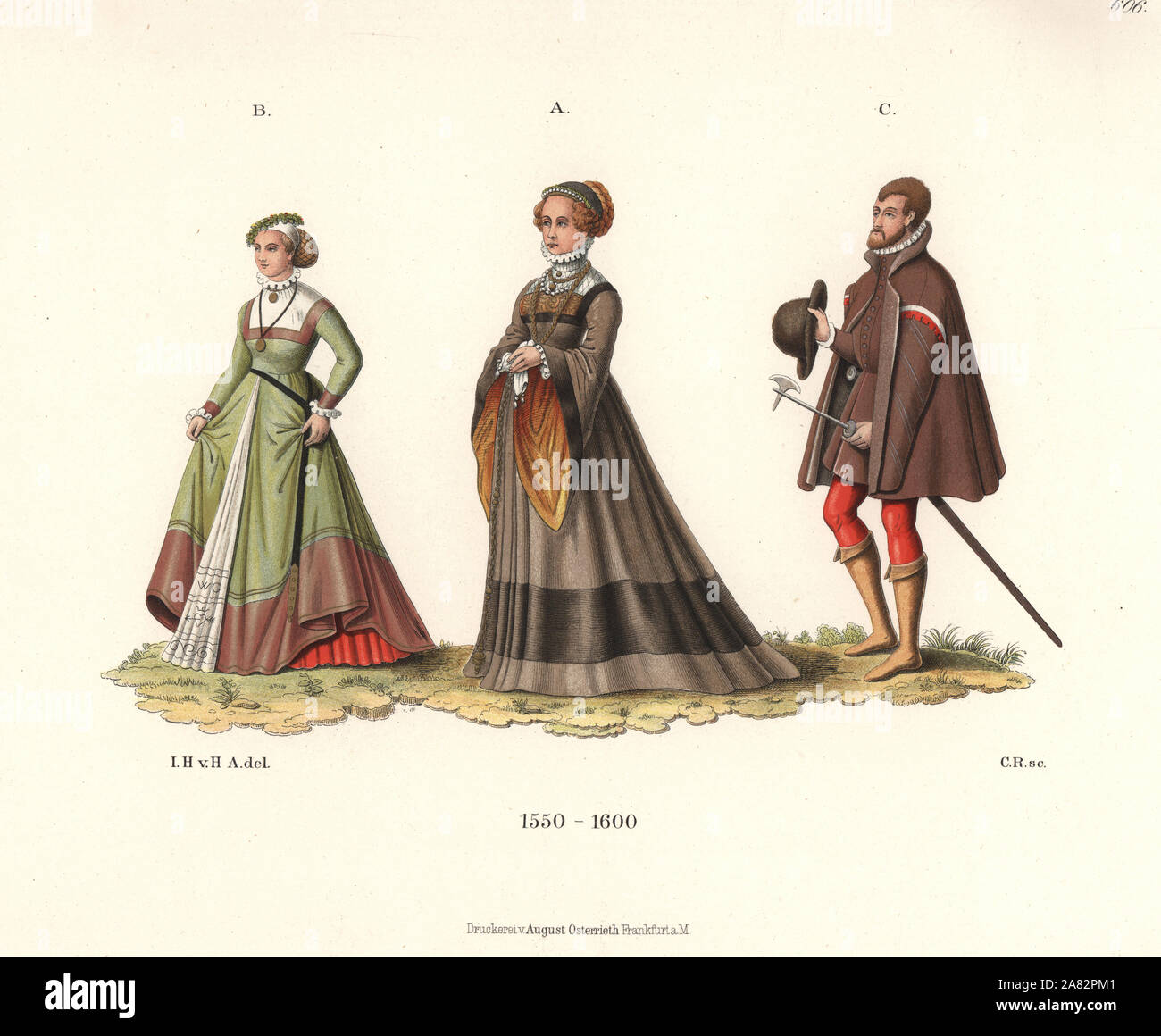 German bride from Augsburg, a maiden from Marburg, and a Stadtknecht with his symbol of office, a small axe. Chromolithograph from Hefner-Alteneck's Costumes, Artworks and Appliances from the Middle Ages to the 17th Century, Frankfurt, 1889. Illustration by Dr. Jakob Heinrich von Hefner-Alteneck, lithographed by C. Regnier. Dr. Hefner-Alteneck (1811-1903) was a German museum curator, archaeologist, art historian, illustrator and etcher. Stock Photohttps://www.alamy.com/image-license-details/?v=1https://www.alamy.com/german-bride-from-augsburg-a-maiden-from-marburg-and-a-stadtknecht-with-his-symbol-of-office-a-small-axe-chromolithograph-from-hefner-altenecks-costumes-artworks-and-appliances-from-the-middle-ages-to-the-17th-century-frankfurt-1889-illustration-by-dr-jakob-heinrich-von-hefner-alteneck-lithographed-by-c-regnier-dr-hefner-alteneck-1811-1903-was-a-german-museum-curator-archaeologist-art-historian-illustrator-and-etcher-image331975953.html
German bride from Augsburg, a maiden from Marburg, and a Stadtknecht with his symbol of office, a small axe. Chromolithograph from Hefner-Alteneck's Costumes, Artworks and Appliances from the Middle Ages to the 17th Century, Frankfurt, 1889. Illustration by Dr. Jakob Heinrich von Hefner-Alteneck, lithographed by C. Regnier. Dr. Hefner-Alteneck (1811-1903) was a German museum curator, archaeologist, art historian, illustrator and etcher. Stock Photohttps://www.alamy.com/image-license-details/?v=1https://www.alamy.com/german-bride-from-augsburg-a-maiden-from-marburg-and-a-stadtknecht-with-his-symbol-of-office-a-small-axe-chromolithograph-from-hefner-altenecks-costumes-artworks-and-appliances-from-the-middle-ages-to-the-17th-century-frankfurt-1889-illustration-by-dr-jakob-heinrich-von-hefner-alteneck-lithographed-by-c-regnier-dr-hefner-alteneck-1811-1903-was-a-german-museum-curator-archaeologist-art-historian-illustrator-and-etcher-image331975953.htmlRM2A82PM1–German bride from Augsburg, a maiden from Marburg, and a Stadtknecht with his symbol of office, a small axe. Chromolithograph from Hefner-Alteneck's Costumes, Artworks and Appliances from the Middle Ages to the 17th Century, Frankfurt, 1889. Illustration by Dr. Jakob Heinrich von Hefner-Alteneck, lithographed by C. Regnier. Dr. Hefner-Alteneck (1811-1903) was a German museum curator, archaeologist, art historian, illustrator and etcher.
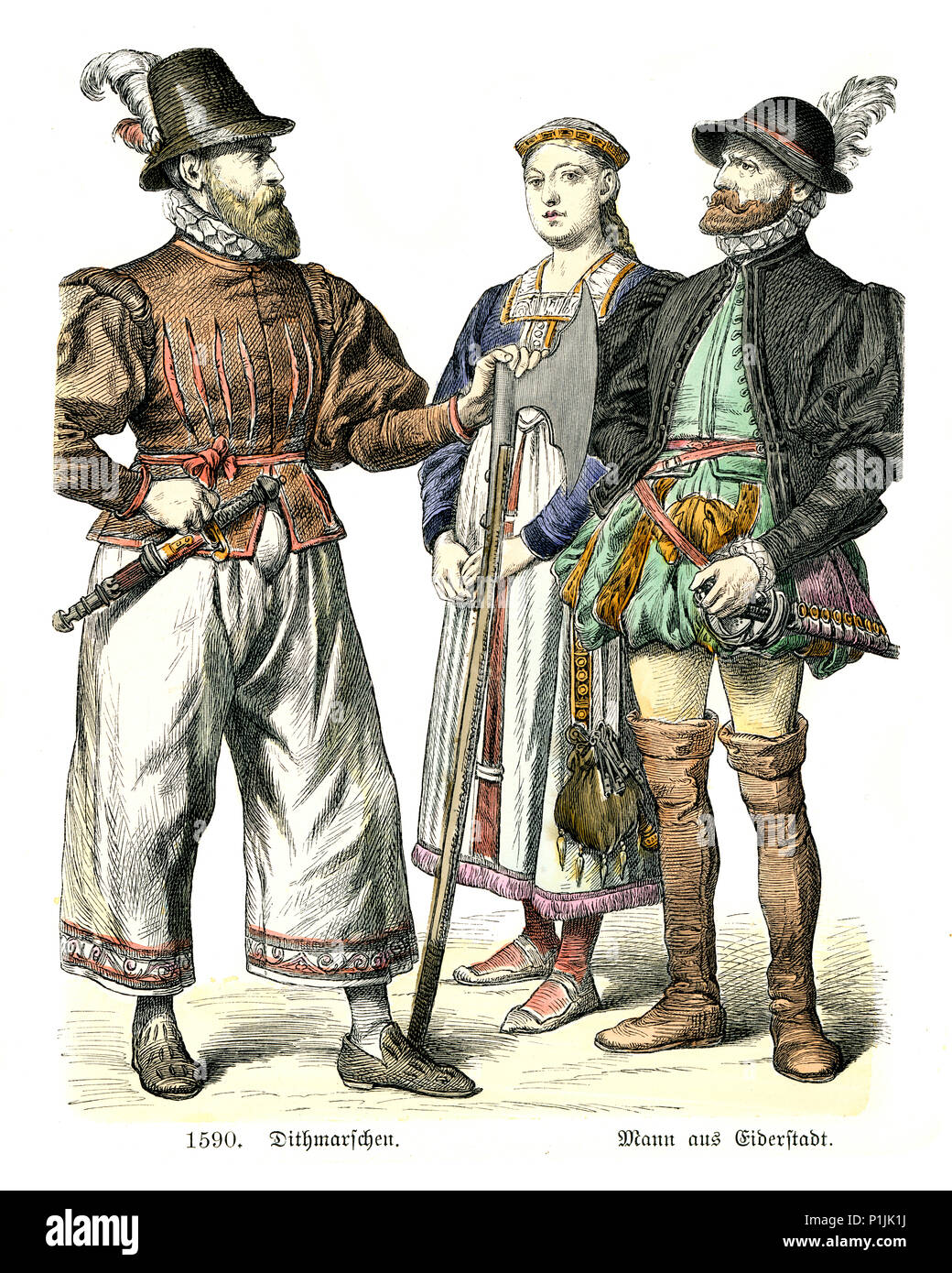 Vintage engraving of History of Fashion, Costumes of Germany 16th Century. Man and woman of Eiderstedt, Schleswig-Holstein and man of Dithmarschen, 15 Stock Photohttps://www.alamy.com/image-license-details/?v=1https://www.alamy.com/vintage-engraving-of-history-of-fashion-costumes-of-germany-16th-century-man-and-woman-of-eiderstedt-schleswig-holstein-and-man-of-dithmarschen-15-image207549150.html
Vintage engraving of History of Fashion, Costumes of Germany 16th Century. Man and woman of Eiderstedt, Schleswig-Holstein and man of Dithmarschen, 15 Stock Photohttps://www.alamy.com/image-license-details/?v=1https://www.alamy.com/vintage-engraving-of-history-of-fashion-costumes-of-germany-16th-century-man-and-woman-of-eiderstedt-schleswig-holstein-and-man-of-dithmarschen-15-image207549150.htmlRMP1JK1J–Vintage engraving of History of Fashion, Costumes of Germany 16th Century. Man and woman of Eiderstedt, Schleswig-Holstein and man of Dithmarschen, 15
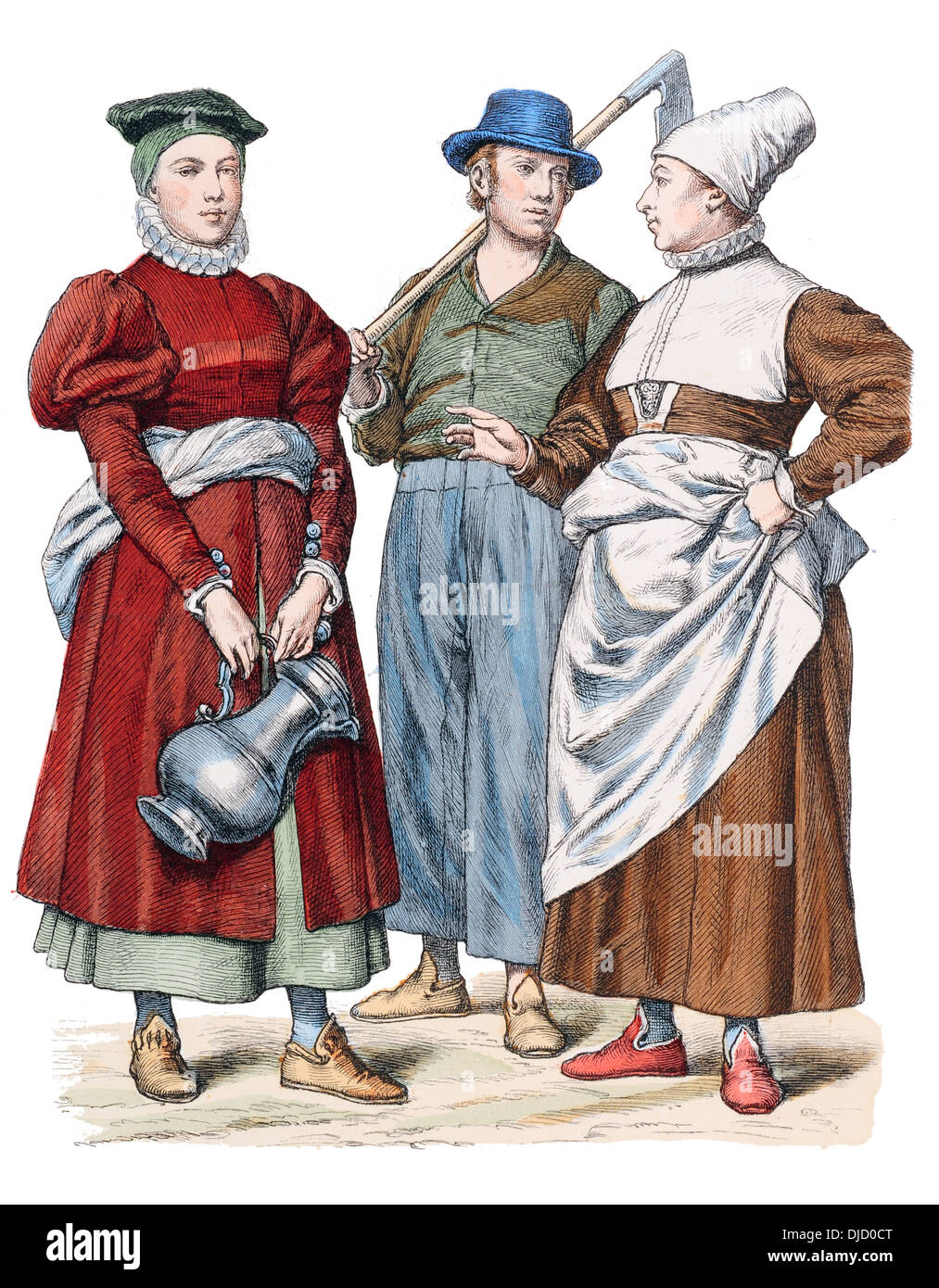 Late 16th Century XVI 1500s German Costumes (Left to right) woman from Ockholm and couple from Pomerania Stock Photohttps://www.alamy.com/image-license-details/?v=1https://www.alamy.com/late-16th-century-xvi-1500s-german-costumes-left-to-right-woman-from-image62980648.html
Late 16th Century XVI 1500s German Costumes (Left to right) woman from Ockholm and couple from Pomerania Stock Photohttps://www.alamy.com/image-license-details/?v=1https://www.alamy.com/late-16th-century-xvi-1500s-german-costumes-left-to-right-woman-from-image62980648.htmlRFDJD0CT–Late 16th Century XVI 1500s German Costumes (Left to right) woman from Ockholm and couple from Pomerania
 Miner. Drawing and engraving by Jost Amman in the 16th century. Sciences & Lettres au Moyen Age et à l'époque de la Renaissance. Paris, 1877. Author: Jost Amman (1539-1591). Swiss-German artist. Stock Photohttps://www.alamy.com/image-license-details/?v=1https://www.alamy.com/miner-drawing-and-engraving-by-jost-amman-in-the-16th-century-sciences-lettres-au-moyen-age-et-lpoque-de-la-renaissance-paris-1877-author-jost-amman-1539-1591-swiss-german-artist-image593301078.html
Miner. Drawing and engraving by Jost Amman in the 16th century. Sciences & Lettres au Moyen Age et à l'époque de la Renaissance. Paris, 1877. Author: Jost Amman (1539-1591). Swiss-German artist. Stock Photohttps://www.alamy.com/image-license-details/?v=1https://www.alamy.com/miner-drawing-and-engraving-by-jost-amman-in-the-16th-century-sciences-lettres-au-moyen-age-et-lpoque-de-la-renaissance-paris-1877-author-jost-amman-1539-1591-swiss-german-artist-image593301078.htmlRM2WD75G6–Miner. Drawing and engraving by Jost Amman in the 16th century. Sciences & Lettres au Moyen Age et à l'époque de la Renaissance. Paris, 1877. Author: Jost Amman (1539-1591). Swiss-German artist.
 Doctrinal axes: 5968 of the 11th century. 5969 German, 14th century.5970 Venetian, 16th century. 5971 Swiss, 16th century. 5972 English. 5973 Riding axe, 16th century. No. 5974-5977 Army hammers: 5974 Swiss, 15th century. 5975 Lucerne hammer, 14th century, 5976 hammer of a Hussite leader, 15th century. 5977 Equestrian hammer, 16th century., , (encyclopedia, 1893) Stock Photohttps://www.alamy.com/image-license-details/?v=1https://www.alamy.com/doctrinal-axes-5968-of-the-11th-century-5969-german-14th-century5970-venetian-16th-century-5971-swiss-16th-century-5972-english-5973-riding-axe-16th-century-no-5974-5977-army-hammers-5974-swiss-15th-century-5975-lucerne-hammer-14th-century-5976-hammer-of-a-hussite-leader-15th-century-5977-equestrian-hammer-16th-century-encyclopedia-1893-image255274186.html
Doctrinal axes: 5968 of the 11th century. 5969 German, 14th century.5970 Venetian, 16th century. 5971 Swiss, 16th century. 5972 English. 5973 Riding axe, 16th century. No. 5974-5977 Army hammers: 5974 Swiss, 15th century. 5975 Lucerne hammer, 14th century, 5976 hammer of a Hussite leader, 15th century. 5977 Equestrian hammer, 16th century., , (encyclopedia, 1893) Stock Photohttps://www.alamy.com/image-license-details/?v=1https://www.alamy.com/doctrinal-axes-5968-of-the-11th-century-5969-german-14th-century5970-venetian-16th-century-5971-swiss-16th-century-5972-english-5973-riding-axe-16th-century-no-5974-5977-army-hammers-5974-swiss-15th-century-5975-lucerne-hammer-14th-century-5976-hammer-of-a-hussite-leader-15th-century-5977-equestrian-hammer-16th-century-encyclopedia-1893-image255274186.htmlRMTR8MR6–Doctrinal axes: 5968 of the 11th century. 5969 German, 14th century.5970 Venetian, 16th century. 5971 Swiss, 16th century. 5972 English. 5973 Riding axe, 16th century. No. 5974-5977 Army hammers: 5974 Swiss, 15th century. 5975 Lucerne hammer, 14th century, 5976 hammer of a Hussite leader, 15th century. 5977 Equestrian hammer, 16th century., , (encyclopedia, 1893)
 German male costumes of 1526-1546. Stock Photohttps://www.alamy.com/image-license-details/?v=1https://www.alamy.com/stock-photo-german-male-costumes-of-1526-1546-72535805.html
German male costumes of 1526-1546. Stock Photohttps://www.alamy.com/image-license-details/?v=1https://www.alamy.com/stock-photo-german-male-costumes-of-1526-1546-72535805.htmlRME6084D–German male costumes of 1526-1546.
 'Frontispiece to a Catalan-German Dictionary dated 1502', (1934). Artist: Unknown. Stock Photohttps://www.alamy.com/image-license-details/?v=1https://www.alamy.com/stock-photo-frontispiece-to-a-catalan-german-dictionary-dated-1502-1934-artist-135311982.html
'Frontispiece to a Catalan-German Dictionary dated 1502', (1934). Artist: Unknown. Stock Photohttps://www.alamy.com/image-license-details/?v=1https://www.alamy.com/stock-photo-frontispiece-to-a-catalan-german-dictionary-dated-1502-1934-artist-135311982.htmlRMHT3YPP–'Frontispiece to a Catalan-German Dictionary dated 1502', (1934). Artist: Unknown.
 German army officer with axe and voluminous breeches, and a countess of Holland and Zeeland wearing a veil. Stock Photohttps://www.alamy.com/image-license-details/?v=1https://www.alamy.com/stock-photo-german-army-officer-with-axe-and-voluminous-breeches-and-a-countess-43216398.html
German army officer with axe and voluminous breeches, and a countess of Holland and Zeeland wearing a veil. Stock Photohttps://www.alamy.com/image-license-details/?v=1https://www.alamy.com/stock-photo-german-army-officer-with-axe-and-voluminous-breeches-and-a-countess-43216398.htmlRMCE8JXP–German army officer with axe and voluminous breeches, and a countess of Holland and Zeeland wearing a veil.
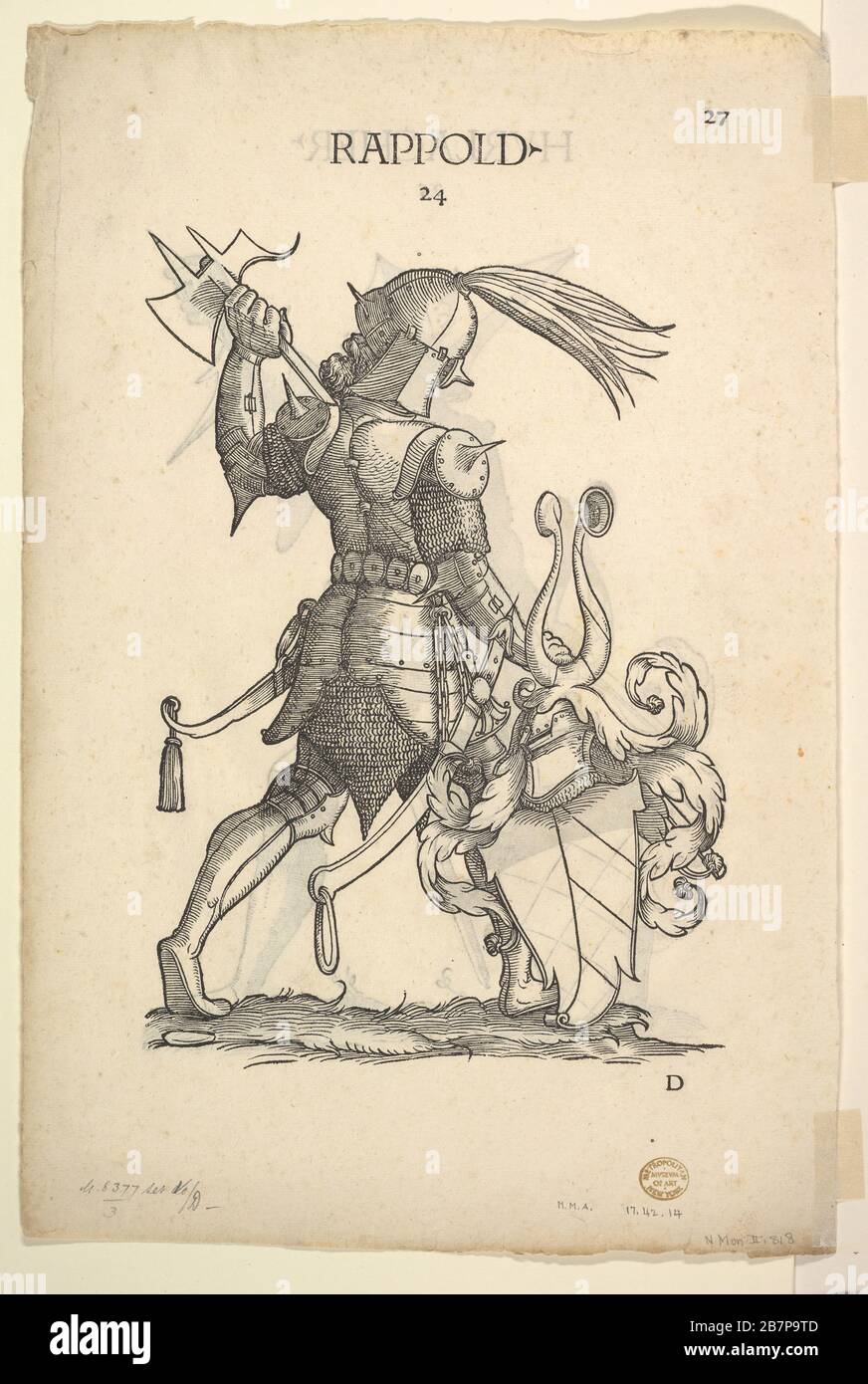 Hurlacher (recto) and Rappold (verso) Families, from Paul Hector Mair’s Bericht und anzeigen aller Herren Geschlecht der loblichen Statt Augspurg, mid 16th century. Stock Photohttps://www.alamy.com/image-license-details/?v=1https://www.alamy.com/hurlacher-recto-and-rappold-verso-families-from-paul-hector-mairx2019s-bericht-und-anzeigen-aller-herren-geschlecht-der-loblichen-statt-augspurg-mid-16th-century-image349000637.html
Hurlacher (recto) and Rappold (verso) Families, from Paul Hector Mair’s Bericht und anzeigen aller Herren Geschlecht der loblichen Statt Augspurg, mid 16th century. Stock Photohttps://www.alamy.com/image-license-details/?v=1https://www.alamy.com/hurlacher-recto-and-rappold-verso-families-from-paul-hector-mairx2019s-bericht-und-anzeigen-aller-herren-geschlecht-der-loblichen-statt-augspurg-mid-16th-century-image349000637.htmlRM2B7P9TD–Hurlacher (recto) and Rappold (verso) Families, from Paul Hector Mair’s Bericht und anzeigen aller Herren Geschlecht der loblichen Statt Augspurg, mid 16th century.
 Weapons in the Meyrick Collection of armour at South Kensington, 1869. '1. Pike; 16th century. 2. Pike. 3. Partisan; English. 4. Bill; English; late 15th century. 5. Ranseur; English. 6. Voulge (or Langue-de-boeuf). 7. Glave; English; reign of Henry VII. 8. Military Fork; 16th century. 9. Partisan; English; reign of Edward IV. 10. Halbard; English or German; reign of Henry VII. 11. Morning Star; English; 12th-15th century. 12. Morning Star. 13. 'Holy-Water Sprinkle'...14. Holy-Water Sprinkle; English; 15th century. 15. Spetum; English.... 16. Gisarme; English; 11th-16th century. 17. Lochaber A Stock Photohttps://www.alamy.com/image-license-details/?v=1https://www.alamy.com/weapons-in-the-meyrick-collection-of-armour-at-south-kensington-1869-1-pike-16th-century-2-pike-3-partisan-english-4-bill-english-late-15th-century-5-ranseur-english-6-voulge-or-langue-de-boeuf-7-glave-english-reign-of-henry-vii-8-military-fork-16th-century-9-partisan-english-reign-of-edward-iv-10-halbard-english-or-german-reign-of-henry-vii-11-morning-star-english-12th-15th-century-12-morning-star-13-holy-water-sprinkle14-holy-water-sprinkle-english-15th-century-15-spetum-english-16-gisarme-english-11th-16th-century-17-lochaber-a-image608998441.html
Weapons in the Meyrick Collection of armour at South Kensington, 1869. '1. Pike; 16th century. 2. Pike. 3. Partisan; English. 4. Bill; English; late 15th century. 5. Ranseur; English. 6. Voulge (or Langue-de-boeuf). 7. Glave; English; reign of Henry VII. 8. Military Fork; 16th century. 9. Partisan; English; reign of Edward IV. 10. Halbard; English or German; reign of Henry VII. 11. Morning Star; English; 12th-15th century. 12. Morning Star. 13. 'Holy-Water Sprinkle'...14. Holy-Water Sprinkle; English; 15th century. 15. Spetum; English.... 16. Gisarme; English; 11th-16th century. 17. Lochaber A Stock Photohttps://www.alamy.com/image-license-details/?v=1https://www.alamy.com/weapons-in-the-meyrick-collection-of-armour-at-south-kensington-1869-1-pike-16th-century-2-pike-3-partisan-english-4-bill-english-late-15th-century-5-ranseur-english-6-voulge-or-langue-de-boeuf-7-glave-english-reign-of-henry-vii-8-military-fork-16th-century-9-partisan-english-reign-of-edward-iv-10-halbard-english-or-german-reign-of-henry-vii-11-morning-star-english-12th-15th-century-12-morning-star-13-holy-water-sprinkle14-holy-water-sprinkle-english-15th-century-15-spetum-english-16-gisarme-english-11th-16th-century-17-lochaber-a-image608998441.htmlRM2XAP7M9–Weapons in the Meyrick Collection of armour at South Kensington, 1869. '1. Pike; 16th century. 2. Pike. 3. Partisan; English. 4. Bill; English; late 15th century. 5. Ranseur; English. 6. Voulge (or Langue-de-boeuf). 7. Glave; English; reign of Henry VII. 8. Military Fork; 16th century. 9. Partisan; English; reign of Edward IV. 10. Halbard; English or German; reign of Henry VII. 11. Morning Star; English; 12th-15th century. 12. Morning Star. 13. 'Holy-Water Sprinkle'...14. Holy-Water Sprinkle; English; 15th century. 15. Spetum; English.... 16. Gisarme; English; 11th-16th century. 17. Lochaber A
 Halberd, c. 1520. Germany, 16th century. Steel, pierced quatrefoil; rectangular wood haft with planed corners; overall: 182.3 cm (71 3/4 in.); blade: 24.2 cm (9 1/2 in.). The halberd was a staff weapon favored by European infantries (foot soldiers) of the 1400s and 1500s for its versatility and deadly effect. The word halberd comes from the German words Halm (staff) and Barte (axe). The halberd is, in fact, an axe that served multiple functions: the axe blade was used for hacking, the spike for thrusting, and the beak for piercing plate armor or for pulling a knight from his saddle. The halbe Stock Photohttps://www.alamy.com/image-license-details/?v=1https://www.alamy.com/halberd-c-1520-germany-16th-century-steel-pierced-quatrefoil-rectangular-wood-haft-with-planed-corners-overall-1823-cm-71-34-in-blade-242-cm-9-12-in-the-halberd-was-a-staff-weapon-favored-by-european-infantries-foot-soldiers-of-the-1400s-and-1500s-for-its-versatility-and-deadly-effect-the-word-halberd-comes-from-the-german-words-halm-staff-and-barte-axe-the-halberd-is-in-fact-an-axe-that-served-multiple-functions-the-axe-blade-was-used-for-hacking-the-spike-for-thrusting-and-the-beak-for-piercing-plate-armor-or-for-pulling-a-knight-from-his-saddle-the-halbe-image448089743.html
Halberd, c. 1520. Germany, 16th century. Steel, pierced quatrefoil; rectangular wood haft with planed corners; overall: 182.3 cm (71 3/4 in.); blade: 24.2 cm (9 1/2 in.). The halberd was a staff weapon favored by European infantries (foot soldiers) of the 1400s and 1500s for its versatility and deadly effect. The word halberd comes from the German words Halm (staff) and Barte (axe). The halberd is, in fact, an axe that served multiple functions: the axe blade was used for hacking, the spike for thrusting, and the beak for piercing plate armor or for pulling a knight from his saddle. The halbe Stock Photohttps://www.alamy.com/image-license-details/?v=1https://www.alamy.com/halberd-c-1520-germany-16th-century-steel-pierced-quatrefoil-rectangular-wood-haft-with-planed-corners-overall-1823-cm-71-34-in-blade-242-cm-9-12-in-the-halberd-was-a-staff-weapon-favored-by-european-infantries-foot-soldiers-of-the-1400s-and-1500s-for-its-versatility-and-deadly-effect-the-word-halberd-comes-from-the-german-words-halm-staff-and-barte-axe-the-halberd-is-in-fact-an-axe-that-served-multiple-functions-the-axe-blade-was-used-for-hacking-the-spike-for-thrusting-and-the-beak-for-piercing-plate-armor-or-for-pulling-a-knight-from-his-saddle-the-halbe-image448089743.htmlRM2H10713–Halberd, c. 1520. Germany, 16th century. Steel, pierced quatrefoil; rectangular wood haft with planed corners; overall: 182.3 cm (71 3/4 in.); blade: 24.2 cm (9 1/2 in.). The halberd was a staff weapon favored by European infantries (foot soldiers) of the 1400s and 1500s for its versatility and deadly effect. The word halberd comes from the German words Halm (staff) and Barte (axe). The halberd is, in fact, an axe that served multiple functions: the axe blade was used for hacking, the spike for thrusting, and the beak for piercing plate armor or for pulling a knight from his saddle. The halbe
 'Cain slaying Abel', 1511 (1906). Artist: Albrecht Durer. Stock Photohttps://www.alamy.com/image-license-details/?v=1https://www.alamy.com/cain-slaying-abel-1511-1906-artist-albrecht-durer-image262781532.html
'Cain slaying Abel', 1511 (1906). Artist: Albrecht Durer. Stock Photohttps://www.alamy.com/image-license-details/?v=1https://www.alamy.com/cain-slaying-abel-1511-1906-artist-albrecht-durer-image262781532.htmlRMW7EMEM–'Cain slaying Abel', 1511 (1906). Artist: Albrecht Durer.
 'Frontispiece to a Catalan-German Dictionary dated 1502', (1934). Artist: Unknown. Stock Photohttps://www.alamy.com/image-license-details/?v=1https://www.alamy.com/frontispiece-to-a-catalan-german-dictionary-dated-1502-1934-artist-unknown-image262795127.html
'Frontispiece to a Catalan-German Dictionary dated 1502', (1934). Artist: Unknown. Stock Photohttps://www.alamy.com/image-license-details/?v=1https://www.alamy.com/frontispiece-to-a-catalan-german-dictionary-dated-1502-1934-artist-unknown-image262795127.htmlRMW7F9T7–'Frontispiece to a Catalan-German Dictionary dated 1502', (1934). Artist: Unknown.
 Washing for tin, 1556. Artist: Unknown Stock Photohttps://www.alamy.com/image-license-details/?v=1https://www.alamy.com/washing-for-tin-1556-artist-unknown-image262738378.html
Washing for tin, 1556. Artist: Unknown Stock Photohttps://www.alamy.com/image-license-details/?v=1https://www.alamy.com/washing-for-tin-1556-artist-unknown-image262738378.htmlRMW7CNDE–Washing for tin, 1556. Artist: Unknown
 Arms and armour from the Meyrick Collection, South Kensington, 1869. Pieces on display '...in the galleries belonging to the Great Exhibition Building of 1862...1: a very curious old-fashioned carbine; 2: a sword, with a hilt of peculiar form; 3: the head of a partisan or halberd; 4: a helmet, with vizor like a man's face; 5: the steel gorget of the Duke of Ferrara, decorated in repoussé work, gilt and damascene; 6: the round shield or target formerly belonging to Francis I. of France; of steel, embossed with sculptures, representing the retreat of the English to Calais, in the year 1524. Stock Photohttps://www.alamy.com/image-license-details/?v=1https://www.alamy.com/arms-and-armour-from-the-meyrick-collection-south-kensington-1869-pieces-on-display-in-the-galleries-belonging-to-the-great-exhibition-building-of-18621-a-very-curious-old-fashioned-carbine-2-a-sword-with-a-hilt-of-peculiar-form-3-the-head-of-a-partisan-or-halberd-4-a-helmet-with-vizor-like-a-mans-face-5-the-steel-gorget-of-the-duke-of-ferrara-decorated-in-repoussxe9-work-gilt-and-damascene-6-the-round-shield-or-target-formerly-belonging-to-francis-i-of-france-of-steel-embossed-with-sculptures-representing-the-retreat-of-the-english-to-calais-in-the-year-1524-image608997002.html
Arms and armour from the Meyrick Collection, South Kensington, 1869. Pieces on display '...in the galleries belonging to the Great Exhibition Building of 1862...1: a very curious old-fashioned carbine; 2: a sword, with a hilt of peculiar form; 3: the head of a partisan or halberd; 4: a helmet, with vizor like a man's face; 5: the steel gorget of the Duke of Ferrara, decorated in repoussé work, gilt and damascene; 6: the round shield or target formerly belonging to Francis I. of France; of steel, embossed with sculptures, representing the retreat of the English to Calais, in the year 1524. Stock Photohttps://www.alamy.com/image-license-details/?v=1https://www.alamy.com/arms-and-armour-from-the-meyrick-collection-south-kensington-1869-pieces-on-display-in-the-galleries-belonging-to-the-great-exhibition-building-of-18621-a-very-curious-old-fashioned-carbine-2-a-sword-with-a-hilt-of-peculiar-form-3-the-head-of-a-partisan-or-halberd-4-a-helmet-with-vizor-like-a-mans-face-5-the-steel-gorget-of-the-duke-of-ferrara-decorated-in-repoussxe9-work-gilt-and-damascene-6-the-round-shield-or-target-formerly-belonging-to-francis-i-of-france-of-steel-embossed-with-sculptures-representing-the-retreat-of-the-english-to-calais-in-the-year-1524-image608997002.htmlRM2XAP5TX–Arms and armour from the Meyrick Collection, South Kensington, 1869. Pieces on display '...in the galleries belonging to the Great Exhibition Building of 1862...1: a very curious old-fashioned carbine; 2: a sword, with a hilt of peculiar form; 3: the head of a partisan or halberd; 4: a helmet, with vizor like a man's face; 5: the steel gorget of the Duke of Ferrara, decorated in repoussé work, gilt and damascene; 6: the round shield or target formerly belonging to Francis I. of France; of steel, embossed with sculptures, representing the retreat of the English to Calais, in the year 1524.
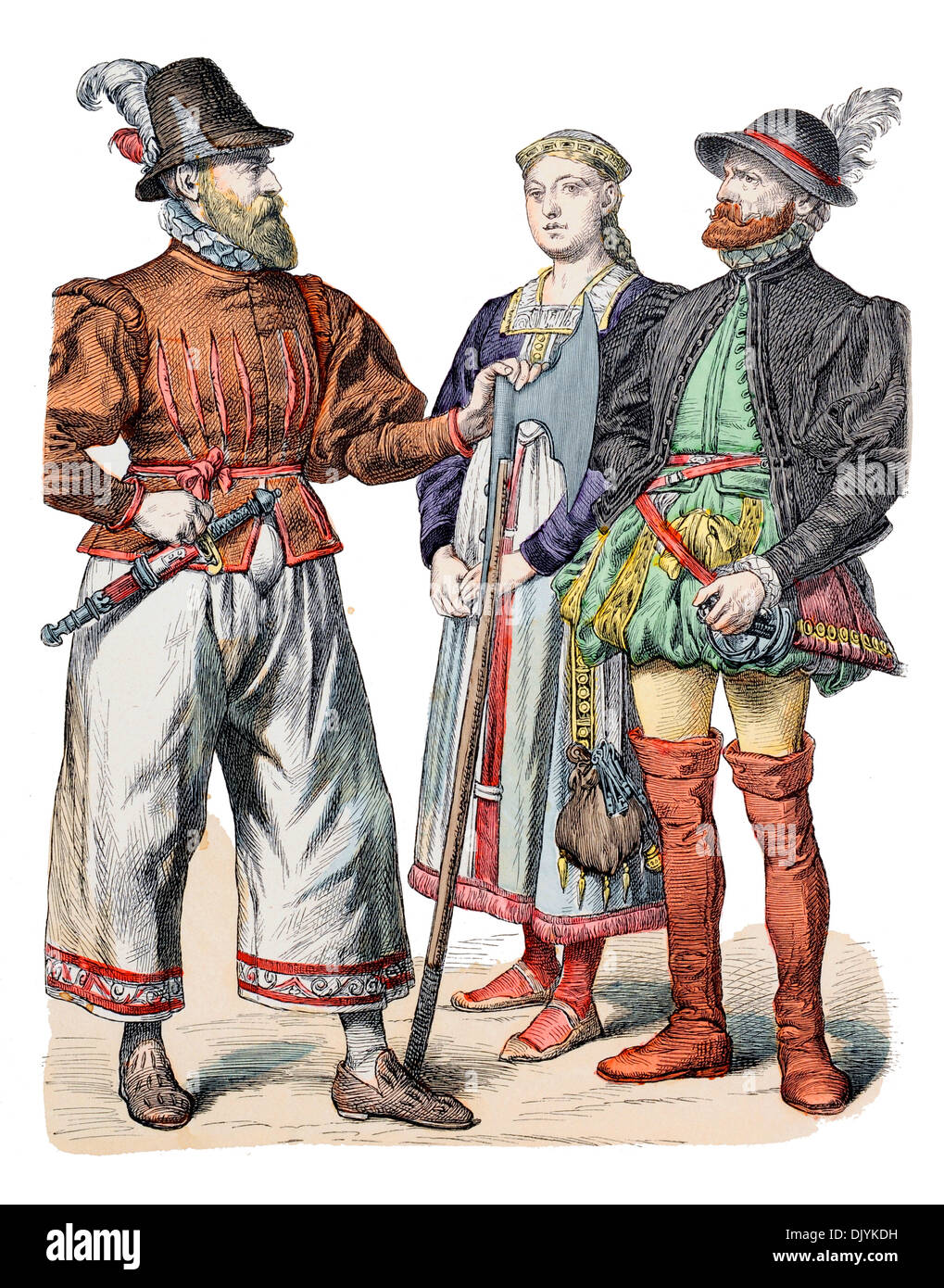 16th Century XVI 1500s Germany Friesland man from Diethmarschen and couple from Eiderstadt Stock Photohttps://www.alamy.com/image-license-details/?v=1https://www.alamy.com/16th-century-xvi-1500s-germany-friesland-man-from-diethmarschen-and-image63302893.html
16th Century XVI 1500s Germany Friesland man from Diethmarschen and couple from Eiderstadt Stock Photohttps://www.alamy.com/image-license-details/?v=1https://www.alamy.com/16th-century-xvi-1500s-germany-friesland-man-from-diethmarschen-and-image63302893.htmlRFDJYKDH–16th Century XVI 1500s Germany Friesland man from Diethmarschen and couple from Eiderstadt
 German bride from Augsburg, a maiden from Marburg, and a Stadtknecht with his symbol of office, a small axe. Chromolithograph from Hefner-Alteneck's Costumes, Artworks and Appliances from the Middle Ages to the 17th Century, Frankfurt, 1889. Illustration by Dr. Jakob Heinrich von Hefner-Alteneck, lithographed by C. Regnier. Dr. Hefner-Alteneck (1811-1903) was a German museum curator, archaeologist, art historian, illustrator and etcher. Stock Photohttps://www.alamy.com/image-license-details/?v=1https://www.alamy.com/german-bride-from-augsburg-a-maiden-from-marburg-and-a-stadtknecht-with-his-symbol-of-office-a-small-axe-chromolithograph-from-hefner-altenecks-costumes-artworks-and-appliances-from-the-middle-ages-to-the-17th-century-frankfurt-1889-illustration-by-dr-jakob-heinrich-von-hefner-alteneck-lithographed-by-c-regnier-dr-hefner-alteneck-1811-1903-was-a-german-museum-curator-archaeologist-art-historian-illustrator-and-etcher-image220220522.html
German bride from Augsburg, a maiden from Marburg, and a Stadtknecht with his symbol of office, a small axe. Chromolithograph from Hefner-Alteneck's Costumes, Artworks and Appliances from the Middle Ages to the 17th Century, Frankfurt, 1889. Illustration by Dr. Jakob Heinrich von Hefner-Alteneck, lithographed by C. Regnier. Dr. Hefner-Alteneck (1811-1903) was a German museum curator, archaeologist, art historian, illustrator and etcher. Stock Photohttps://www.alamy.com/image-license-details/?v=1https://www.alamy.com/german-bride-from-augsburg-a-maiden-from-marburg-and-a-stadtknecht-with-his-symbol-of-office-a-small-axe-chromolithograph-from-hefner-altenecks-costumes-artworks-and-appliances-from-the-middle-ages-to-the-17th-century-frankfurt-1889-illustration-by-dr-jakob-heinrich-von-hefner-alteneck-lithographed-by-c-regnier-dr-hefner-alteneck-1811-1903-was-a-german-museum-curator-archaeologist-art-historian-illustrator-and-etcher-image220220522.htmlRMPP7WEJ–German bride from Augsburg, a maiden from Marburg, and a Stadtknecht with his symbol of office, a small axe. Chromolithograph from Hefner-Alteneck's Costumes, Artworks and Appliances from the Middle Ages to the 17th Century, Frankfurt, 1889. Illustration by Dr. Jakob Heinrich von Hefner-Alteneck, lithographed by C. Regnier. Dr. Hefner-Alteneck (1811-1903) was a German museum curator, archaeologist, art historian, illustrator and etcher.
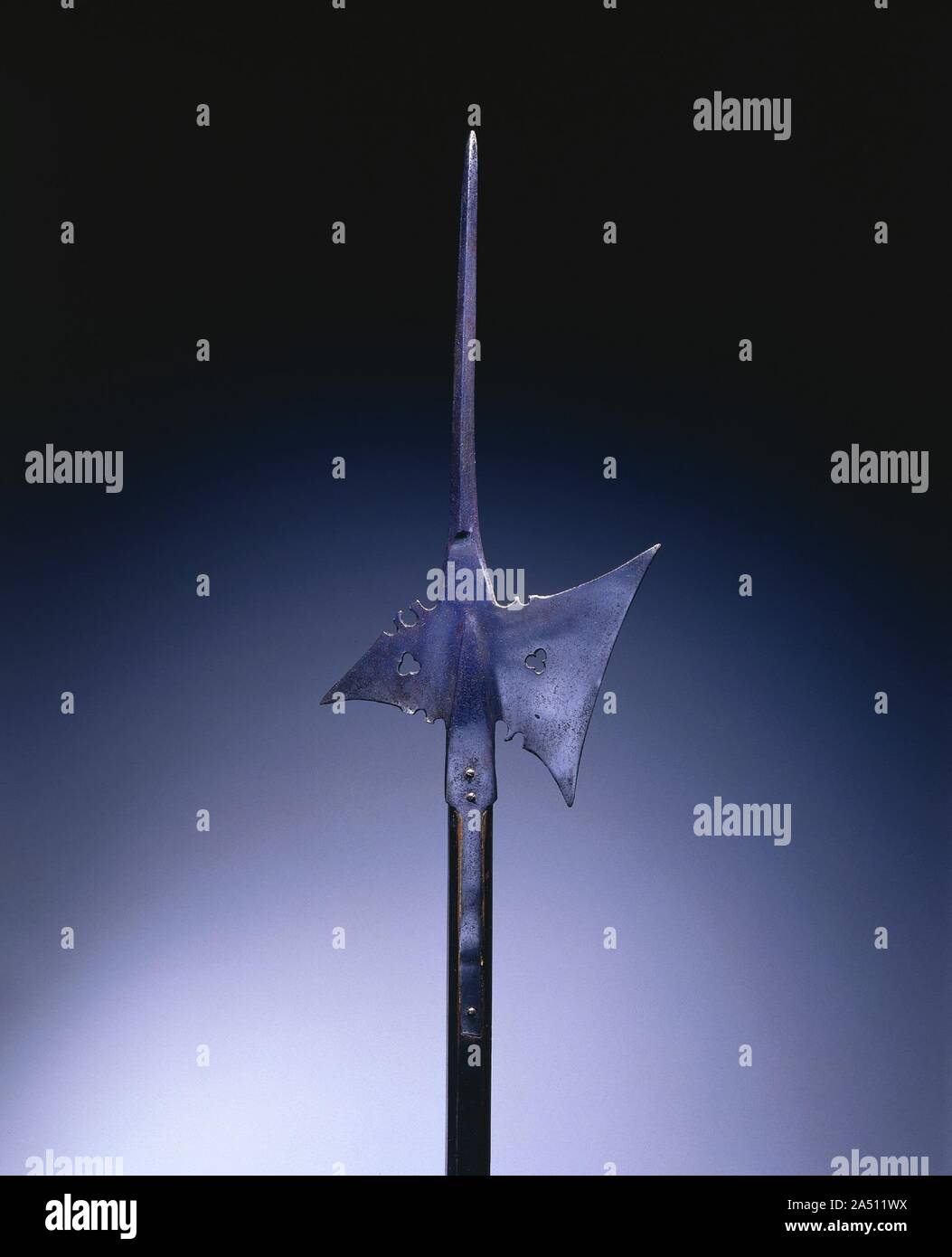 Halberd, c. 1550. The most effecient weapons used by the infantry (foot soldiers) during the 15th and 16th centuries were pole arms (or staff weapons). The halberd, like the examples shown here, was a weapon of great versatility. The word halberd comes from the German words Halm (a staff) and Barte (an axe). The halberd is, in fact, an axe mounted on a long pole with a very specialized shape and function: the axe blade was used for hacking, the spike for thrusting, and the beak either for piercing plate armor or for pulling a knight from his saddle. Used by shock troops, the halberd was the Stock Photohttps://www.alamy.com/image-license-details/?v=1https://www.alamy.com/halberd-c-1550-the-most-effecient-weapons-used-by-the-infantry-foot-soldiers-during-the-15th-and-16th-centuries-were-pole-arms-or-staff-weapons-the-halberd-like-the-examples-shown-here-was-a-weapon-of-great-versatility-the-word-halberd-comes-from-the-german-words-halm-a-staff-and-barte-an-axe-the-halberd-is-in-fact-an-axe-mounted-on-a-long-pole-with-a-very-specialized-shape-and-function-the-axe-blade-was-used-for-hacking-the-spike-for-thrusting-and-the-beak-either-for-piercing-plate-armor-or-for-pulling-a-knight-from-his-saddle-used-by-shock-troops-the-halberd-was-the-image330093734.html
Halberd, c. 1550. The most effecient weapons used by the infantry (foot soldiers) during the 15th and 16th centuries were pole arms (or staff weapons). The halberd, like the examples shown here, was a weapon of great versatility. The word halberd comes from the German words Halm (a staff) and Barte (an axe). The halberd is, in fact, an axe mounted on a long pole with a very specialized shape and function: the axe blade was used for hacking, the spike for thrusting, and the beak either for piercing plate armor or for pulling a knight from his saddle. Used by shock troops, the halberd was the Stock Photohttps://www.alamy.com/image-license-details/?v=1https://www.alamy.com/halberd-c-1550-the-most-effecient-weapons-used-by-the-infantry-foot-soldiers-during-the-15th-and-16th-centuries-were-pole-arms-or-staff-weapons-the-halberd-like-the-examples-shown-here-was-a-weapon-of-great-versatility-the-word-halberd-comes-from-the-german-words-halm-a-staff-and-barte-an-axe-the-halberd-is-in-fact-an-axe-mounted-on-a-long-pole-with-a-very-specialized-shape-and-function-the-axe-blade-was-used-for-hacking-the-spike-for-thrusting-and-the-beak-either-for-piercing-plate-armor-or-for-pulling-a-knight-from-his-saddle-used-by-shock-troops-the-halberd-was-the-image330093734.htmlRM2A511WX–Halberd, c. 1550. The most effecient weapons used by the infantry (foot soldiers) during the 15th and 16th centuries were pole arms (or staff weapons). The halberd, like the examples shown here, was a weapon of great versatility. The word halberd comes from the German words Halm (a staff) and Barte (an axe). The halberd is, in fact, an axe mounted on a long pole with a very specialized shape and function: the axe blade was used for hacking, the spike for thrusting, and the beak either for piercing plate armor or for pulling a knight from his saddle. Used by shock troops, the halberd was the
 Halberd, c. 1580. Germany, late 16th Century. Steel; leaf-shaped head; octagonal woof haft, woolen pompom; overall: 197.5 cm (77 3/4 in.); blade: 22.8 cm (9 in.). The halberd was a staff weapon favored by European infantries (foot soldiers) of the 1400s and 1500s for its versatility and deadly effect. The word halberd comes from the German words Halm (staff) and Barte (axe). The halberd is, in fact, an axe that served multiple functions: the axe blade was used for hacking, the spike for thrusting, and the beak for piercing plate armor or for pulling a knight from his saddle. The halberd was u Stock Photohttps://www.alamy.com/image-license-details/?v=1https://www.alamy.com/halberd-c-1580-germany-late-16th-century-steel-leaf-shaped-head-octagonal-woof-haft-woolen-pompom-overall-1975-cm-77-34-in-blade-228-cm-9-in-the-halberd-was-a-staff-weapon-favored-by-european-infantries-foot-soldiers-of-the-1400s-and-1500s-for-its-versatility-and-deadly-effect-the-word-halberd-comes-from-the-german-words-halm-staff-and-barte-axe-the-halberd-is-in-fact-an-axe-that-served-multiple-functions-the-axe-blade-was-used-for-hacking-the-spike-for-thrusting-and-the-beak-for-piercing-plate-armor-or-for-pulling-a-knight-from-his-saddle-the-halberd-was-u-image448089934.html
Halberd, c. 1580. Germany, late 16th Century. Steel; leaf-shaped head; octagonal woof haft, woolen pompom; overall: 197.5 cm (77 3/4 in.); blade: 22.8 cm (9 in.). The halberd was a staff weapon favored by European infantries (foot soldiers) of the 1400s and 1500s for its versatility and deadly effect. The word halberd comes from the German words Halm (staff) and Barte (axe). The halberd is, in fact, an axe that served multiple functions: the axe blade was used for hacking, the spike for thrusting, and the beak for piercing plate armor or for pulling a knight from his saddle. The halberd was u Stock Photohttps://www.alamy.com/image-license-details/?v=1https://www.alamy.com/halberd-c-1580-germany-late-16th-century-steel-leaf-shaped-head-octagonal-woof-haft-woolen-pompom-overall-1975-cm-77-34-in-blade-228-cm-9-in-the-halberd-was-a-staff-weapon-favored-by-european-infantries-foot-soldiers-of-the-1400s-and-1500s-for-its-versatility-and-deadly-effect-the-word-halberd-comes-from-the-german-words-halm-staff-and-barte-axe-the-halberd-is-in-fact-an-axe-that-served-multiple-functions-the-axe-blade-was-used-for-hacking-the-spike-for-thrusting-and-the-beak-for-piercing-plate-armor-or-for-pulling-a-knight-from-his-saddle-the-halberd-was-u-image448089934.htmlRM2H1077X–Halberd, c. 1580. Germany, late 16th Century. Steel; leaf-shaped head; octagonal woof haft, woolen pompom; overall: 197.5 cm (77 3/4 in.); blade: 22.8 cm (9 in.). The halberd was a staff weapon favored by European infantries (foot soldiers) of the 1400s and 1500s for its versatility and deadly effect. The word halberd comes from the German words Halm (staff) and Barte (axe). The halberd is, in fact, an axe that served multiple functions: the axe blade was used for hacking, the spike for thrusting, and the beak for piercing plate armor or for pulling a knight from his saddle. The halberd was u
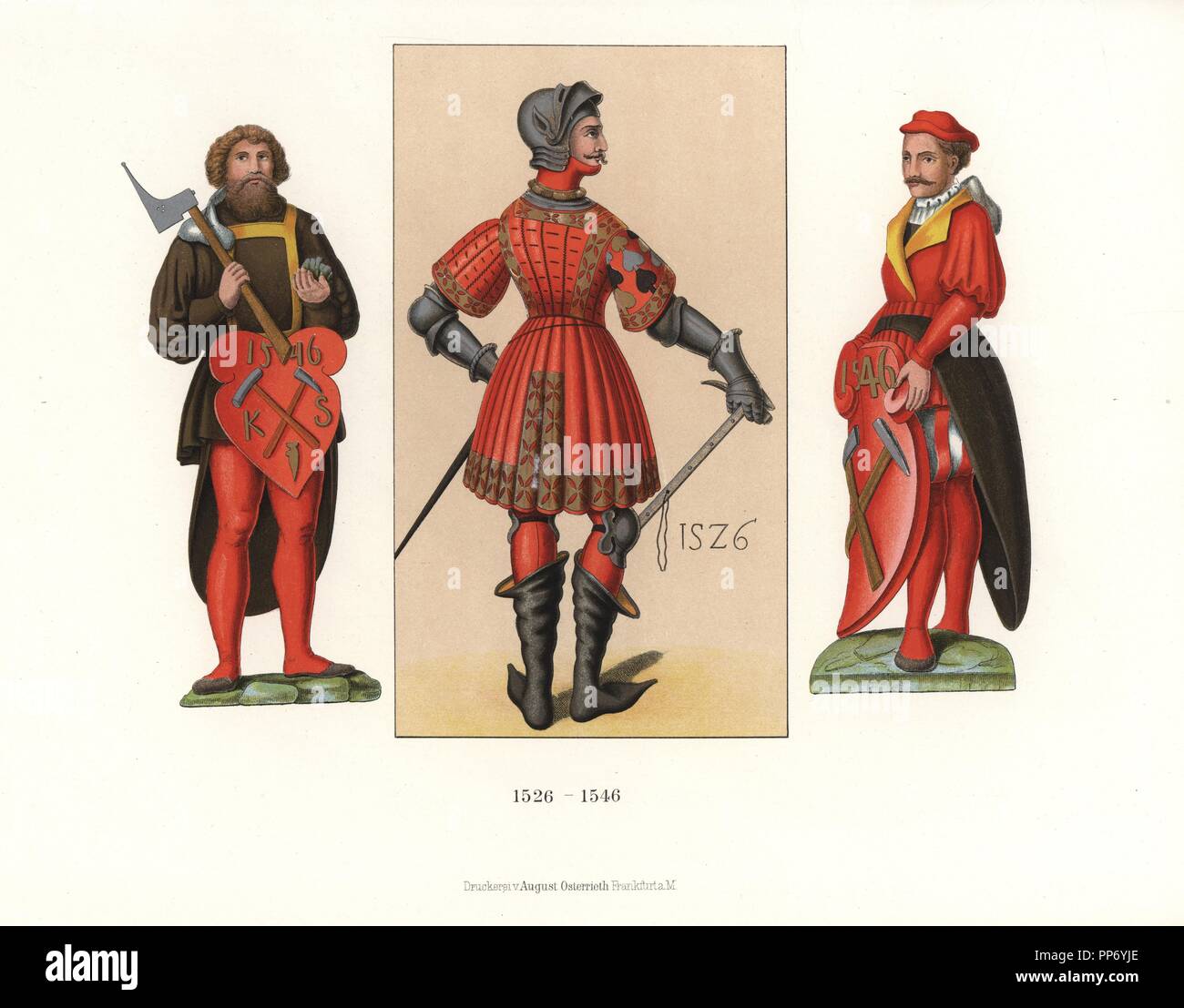 German male costumes of 1526-1546. In the centre is a portrait of Casimir Margrave of Brandenburg, 1526, in suit of armour, helmet, skirts and boots, provided as a pattern for his tailors and armourers. At the sides are 'Knappschaft' miners with lump of coal and pick, and coat of arms with axe and hammer. Chromolithograph from Hefner-Alteneck's 'Costumes, Artworks and Appliances from the Middle Ages to the 17th Century,' Frankfurt, 1889. Dr. Jakob Heinrich von Hefner-Alteneck (1811-1903) was a German museum curator, archaeologist, art historian, illustrator and etcher. Stock Photohttps://www.alamy.com/image-license-details/?v=1https://www.alamy.com/german-male-costumes-of-1526-1546-in-the-centre-is-a-portrait-of-casimir-margrave-of-brandenburg-1526-in-suit-of-armour-helmet-skirts-and-boots-provided-as-a-pattern-for-his-tailors-and-armourers-at-the-sides-are-knappschaft-miners-with-lump-of-coal-and-pick-and-coat-of-arms-with-axe-and-hammer-chromolithograph-from-hefner-altenecks-costumes-artworks-and-appliances-from-the-middle-ages-to-the-17th-century-frankfurt-1889-dr-jakob-heinrich-von-hefner-alteneck-1811-1903-was-a-german-museum-curator-archaeologist-art-historian-illustrator-and-etcher-image220200246.html
German male costumes of 1526-1546. In the centre is a portrait of Casimir Margrave of Brandenburg, 1526, in suit of armour, helmet, skirts and boots, provided as a pattern for his tailors and armourers. At the sides are 'Knappschaft' miners with lump of coal and pick, and coat of arms with axe and hammer. Chromolithograph from Hefner-Alteneck's 'Costumes, Artworks and Appliances from the Middle Ages to the 17th Century,' Frankfurt, 1889. Dr. Jakob Heinrich von Hefner-Alteneck (1811-1903) was a German museum curator, archaeologist, art historian, illustrator and etcher. Stock Photohttps://www.alamy.com/image-license-details/?v=1https://www.alamy.com/german-male-costumes-of-1526-1546-in-the-centre-is-a-portrait-of-casimir-margrave-of-brandenburg-1526-in-suit-of-armour-helmet-skirts-and-boots-provided-as-a-pattern-for-his-tailors-and-armourers-at-the-sides-are-knappschaft-miners-with-lump-of-coal-and-pick-and-coat-of-arms-with-axe-and-hammer-chromolithograph-from-hefner-altenecks-costumes-artworks-and-appliances-from-the-middle-ages-to-the-17th-century-frankfurt-1889-dr-jakob-heinrich-von-hefner-alteneck-1811-1903-was-a-german-museum-curator-archaeologist-art-historian-illustrator-and-etcher-image220200246.htmlRMPP6YJE–German male costumes of 1526-1546. In the centre is a portrait of Casimir Margrave of Brandenburg, 1526, in suit of armour, helmet, skirts and boots, provided as a pattern for his tailors and armourers. At the sides are 'Knappschaft' miners with lump of coal and pick, and coat of arms with axe and hammer. Chromolithograph from Hefner-Alteneck's 'Costumes, Artworks and Appliances from the Middle Ages to the 17th Century,' Frankfurt, 1889. Dr. Jakob Heinrich von Hefner-Alteneck (1811-1903) was a German museum curator, archaeologist, art historian, illustrator and etcher.
 Halberd, c. 1520. The halberd was a staff weapon favored by European infantries (foot soldiers) of the 1400s and 1500s for its versatility and deadly effect. The word halberd comes from the German words Halm (staff) and Barte (axe). The halberd is, in fact, an axe that served multiple functions: the axe blade was used for hacking, the spike for thrusting, and the beak for piercing plate armor or for pulling a knight from his saddle. The halberd was used by shock troops (those who lead an attack) and by Swiss and German mercenaries. After about 1550, the halberd gradually became less functional Stock Photohttps://www.alamy.com/image-license-details/?v=1https://www.alamy.com/halberd-c-1520-the-halberd-was-a-staff-weapon-favored-by-european-infantries-foot-soldiers-of-the-1400s-and-1500s-for-its-versatility-and-deadly-effect-the-word-halberd-comes-from-the-german-words-halm-staff-and-barte-axe-the-halberd-is-in-fact-an-axe-that-served-multiple-functions-the-axe-blade-was-used-for-hacking-the-spike-for-thrusting-and-the-beak-for-piercing-plate-armor-or-for-pulling-a-knight-from-his-saddle-the-halberd-was-used-by-shock-troops-those-who-lead-an-attack-and-by-swiss-and-german-mercenaries-after-about-1550-the-halberd-gradually-became-less-functional-image330093728.html
Halberd, c. 1520. The halberd was a staff weapon favored by European infantries (foot soldiers) of the 1400s and 1500s for its versatility and deadly effect. The word halberd comes from the German words Halm (staff) and Barte (axe). The halberd is, in fact, an axe that served multiple functions: the axe blade was used for hacking, the spike for thrusting, and the beak for piercing plate armor or for pulling a knight from his saddle. The halberd was used by shock troops (those who lead an attack) and by Swiss and German mercenaries. After about 1550, the halberd gradually became less functional Stock Photohttps://www.alamy.com/image-license-details/?v=1https://www.alamy.com/halberd-c-1520-the-halberd-was-a-staff-weapon-favored-by-european-infantries-foot-soldiers-of-the-1400s-and-1500s-for-its-versatility-and-deadly-effect-the-word-halberd-comes-from-the-german-words-halm-staff-and-barte-axe-the-halberd-is-in-fact-an-axe-that-served-multiple-functions-the-axe-blade-was-used-for-hacking-the-spike-for-thrusting-and-the-beak-for-piercing-plate-armor-or-for-pulling-a-knight-from-his-saddle-the-halberd-was-used-by-shock-troops-those-who-lead-an-attack-and-by-swiss-and-german-mercenaries-after-about-1550-the-halberd-gradually-became-less-functional-image330093728.htmlRM2A511WM–Halberd, c. 1520. The halberd was a staff weapon favored by European infantries (foot soldiers) of the 1400s and 1500s for its versatility and deadly effect. The word halberd comes from the German words Halm (staff) and Barte (axe). The halberd is, in fact, an axe that served multiple functions: the axe blade was used for hacking, the spike for thrusting, and the beak for piercing plate armor or for pulling a knight from his saddle. The halberd was used by shock troops (those who lead an attack) and by Swiss and German mercenaries. After about 1550, the halberd gradually became less functional
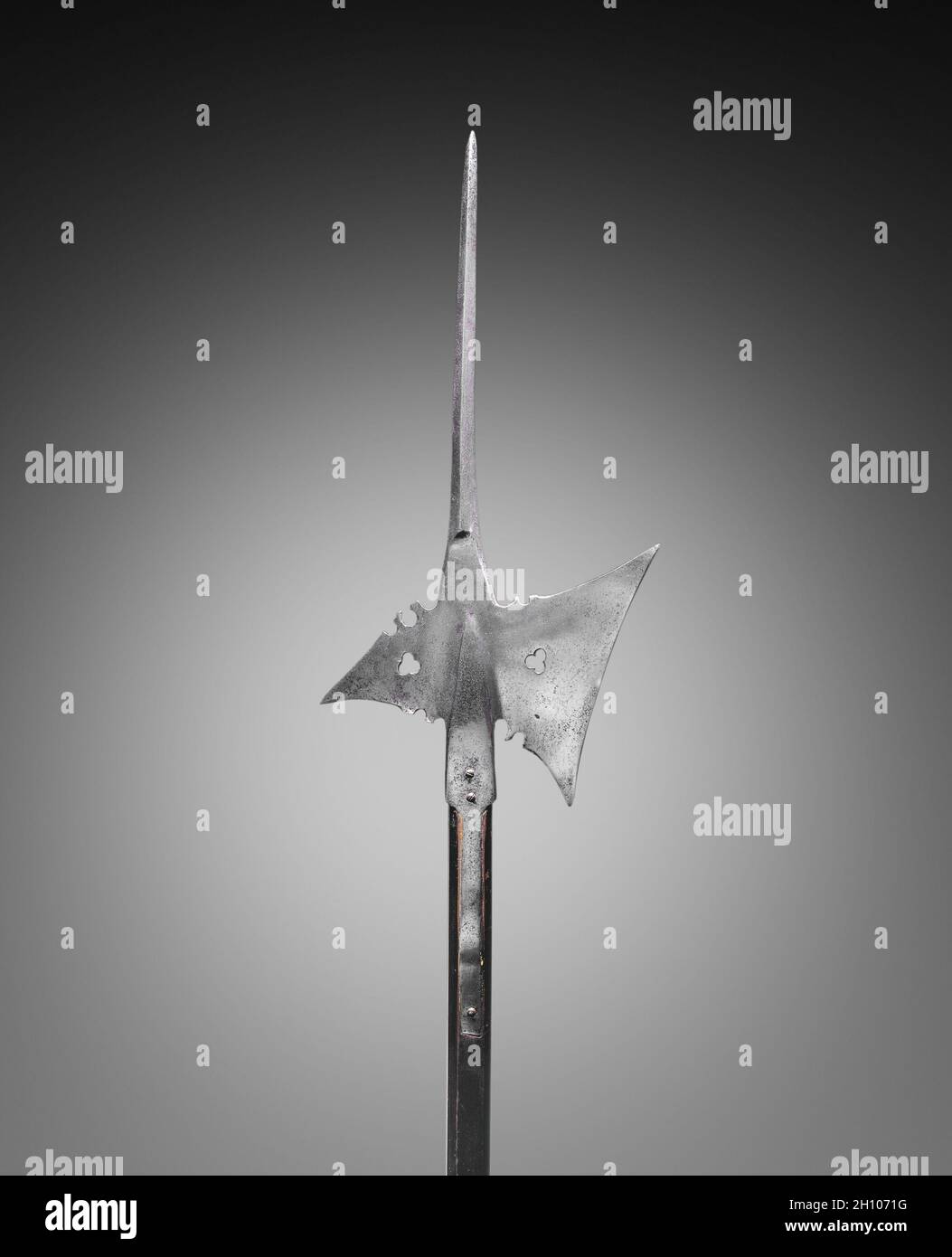 Halberd, c. 1550. Germany, 16th century. Steel, with pierced trefoils; wood haft (rectangular with planed corners); overall: 200.7 cm (79 in.); blade: 25.4 cm (10 in.). The most effecient weapons used by the infantry (foot soldiers) during the 15th and 16th centuries were pole arms (or staff weapons). The halberd, like the examples shown here, was a weapon of great versatility. The word halberd comes from the German words Halm (a staff) and Barte (an axe). The halberd is, in fact, an axe mounted on a long pole with a very specialized shape and function: the axe blade was used for hacking, the Stock Photohttps://www.alamy.com/image-license-details/?v=1https://www.alamy.com/halberd-c-1550-germany-16th-century-steel-with-pierced-trefoils-wood-haft-rectangular-with-planed-corners-overall-2007-cm-79-in-blade-254-cm-10-in-the-most-effecient-weapons-used-by-the-infantry-foot-soldiers-during-the-15th-and-16th-centuries-were-pole-arms-or-staff-weapons-the-halberd-like-the-examples-shown-here-was-a-weapon-of-great-versatility-the-word-halberd-comes-from-the-german-words-halm-a-staff-and-barte-an-axe-the-halberd-is-in-fact-an-axe-mounted-on-a-long-pole-with-a-very-specialized-shape-and-function-the-axe-blade-was-used-for-hacking-the-image448089756.html
Halberd, c. 1550. Germany, 16th century. Steel, with pierced trefoils; wood haft (rectangular with planed corners); overall: 200.7 cm (79 in.); blade: 25.4 cm (10 in.). The most effecient weapons used by the infantry (foot soldiers) during the 15th and 16th centuries were pole arms (or staff weapons). The halberd, like the examples shown here, was a weapon of great versatility. The word halberd comes from the German words Halm (a staff) and Barte (an axe). The halberd is, in fact, an axe mounted on a long pole with a very specialized shape and function: the axe blade was used for hacking, the Stock Photohttps://www.alamy.com/image-license-details/?v=1https://www.alamy.com/halberd-c-1550-germany-16th-century-steel-with-pierced-trefoils-wood-haft-rectangular-with-planed-corners-overall-2007-cm-79-in-blade-254-cm-10-in-the-most-effecient-weapons-used-by-the-infantry-foot-soldiers-during-the-15th-and-16th-centuries-were-pole-arms-or-staff-weapons-the-halberd-like-the-examples-shown-here-was-a-weapon-of-great-versatility-the-word-halberd-comes-from-the-german-words-halm-a-staff-and-barte-an-axe-the-halberd-is-in-fact-an-axe-mounted-on-a-long-pole-with-a-very-specialized-shape-and-function-the-axe-blade-was-used-for-hacking-the-image448089756.htmlRM2H1071G–Halberd, c. 1550. Germany, 16th century. Steel, with pierced trefoils; wood haft (rectangular with planed corners); overall: 200.7 cm (79 in.); blade: 25.4 cm (10 in.). The most effecient weapons used by the infantry (foot soldiers) during the 15th and 16th centuries were pole arms (or staff weapons). The halberd, like the examples shown here, was a weapon of great versatility. The word halberd comes from the German words Halm (a staff) and Barte (an axe). The halberd is, in fact, an axe mounted on a long pole with a very specialized shape and function: the axe blade was used for hacking, the
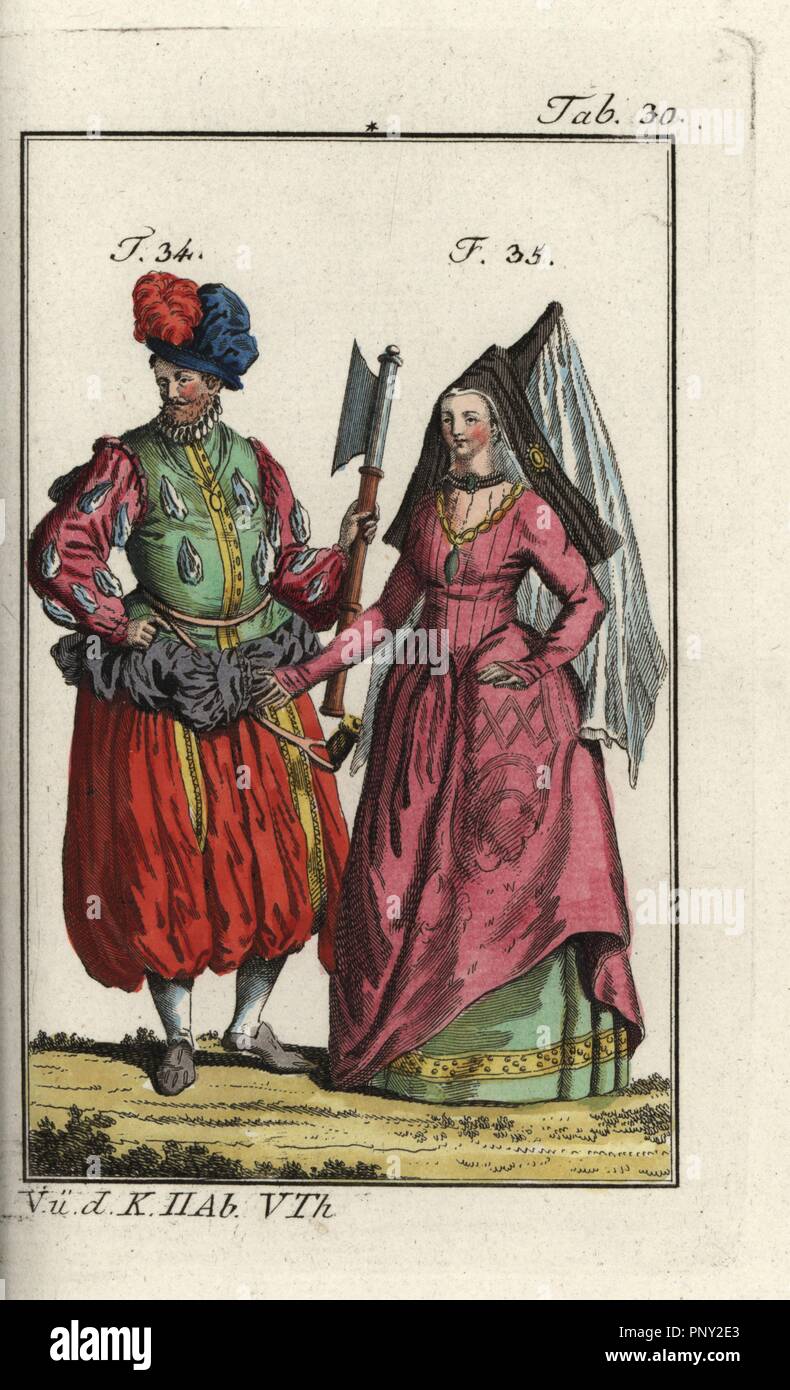 German army officer with axe and voluminous breeches, and a countess of Holland and Zeeland wearing a veil. Handcolored copperplate engraving from Robert von Spalart's 'Historical Picture of the Costumes of the Principal People of Antiquity and of the Middle Ages,' Vienna, 1811. Illustration based on Thomas Jefferys Collection of Dresses of Different Nations, Antient and Modern. After the Designs of Holbein, Van Dyke, Hollar, and others, London, 1757. Stock Photohttps://www.alamy.com/image-license-details/?v=1https://www.alamy.com/german-army-officer-with-axe-and-voluminous-breeches-and-a-countess-of-holland-and-zeeland-wearing-a-veil-handcolored-copperplate-engraving-from-robert-von-spalarts-historical-picture-of-the-costumes-of-the-principal-people-of-antiquity-and-of-the-middle-ages-vienna-1811-illustration-based-on-thomas-jefferys-collection-of-dresses-of-different-nations-antient-and-modern-after-the-designs-of-holbein-van-dyke-hollar-and-others-london-1757-image220026859.html
German army officer with axe and voluminous breeches, and a countess of Holland and Zeeland wearing a veil. Handcolored copperplate engraving from Robert von Spalart's 'Historical Picture of the Costumes of the Principal People of Antiquity and of the Middle Ages,' Vienna, 1811. Illustration based on Thomas Jefferys Collection of Dresses of Different Nations, Antient and Modern. After the Designs of Holbein, Van Dyke, Hollar, and others, London, 1757. Stock Photohttps://www.alamy.com/image-license-details/?v=1https://www.alamy.com/german-army-officer-with-axe-and-voluminous-breeches-and-a-countess-of-holland-and-zeeland-wearing-a-veil-handcolored-copperplate-engraving-from-robert-von-spalarts-historical-picture-of-the-costumes-of-the-principal-people-of-antiquity-and-of-the-middle-ages-vienna-1811-illustration-based-on-thomas-jefferys-collection-of-dresses-of-different-nations-antient-and-modern-after-the-designs-of-holbein-van-dyke-hollar-and-others-london-1757-image220026859.htmlRMPNY2E3–German army officer with axe and voluminous breeches, and a countess of Holland and Zeeland wearing a veil. Handcolored copperplate engraving from Robert von Spalart's 'Historical Picture of the Costumes of the Principal People of Antiquity and of the Middle Ages,' Vienna, 1811. Illustration based on Thomas Jefferys Collection of Dresses of Different Nations, Antient and Modern. After the Designs of Holbein, Van Dyke, Hollar, and others, London, 1757.
 Halberd, c. 1500-1525. The halberd was a staff weapon favored by European infantries (foot soldiers) of the 1400s and 1500s for its versatility and deadly effect. The word halberd comes from the German words Halm (staff) and Barte (axe). The halberd is, in fact, an axe that served multiple functions: the axe blade was used for hacking, the spike for thrusting, and the beak for piercing plate armor or for pulling a knight from his saddle. The halberd was used by shock troops (those who lead an attack) and by Swiss and German mercenaries. After about 1550, the halberd gradually became less funct Stock Photohttps://www.alamy.com/image-license-details/?v=1https://www.alamy.com/halberd-c-1500-1525-the-halberd-was-a-staff-weapon-favored-by-european-infantries-foot-soldiers-of-the-1400s-and-1500s-for-its-versatility-and-deadly-effect-the-word-halberd-comes-from-the-german-words-halm-staff-and-barte-axe-the-halberd-is-in-fact-an-axe-that-served-multiple-functions-the-axe-blade-was-used-for-hacking-the-spike-for-thrusting-and-the-beak-for-piercing-plate-armor-or-for-pulling-a-knight-from-his-saddle-the-halberd-was-used-by-shock-troops-those-who-lead-an-attack-and-by-swiss-and-german-mercenaries-after-about-1550-the-halberd-gradually-became-less-funct-image330093747.html
Halberd, c. 1500-1525. The halberd was a staff weapon favored by European infantries (foot soldiers) of the 1400s and 1500s for its versatility and deadly effect. The word halberd comes from the German words Halm (staff) and Barte (axe). The halberd is, in fact, an axe that served multiple functions: the axe blade was used for hacking, the spike for thrusting, and the beak for piercing plate armor or for pulling a knight from his saddle. The halberd was used by shock troops (those who lead an attack) and by Swiss and German mercenaries. After about 1550, the halberd gradually became less funct Stock Photohttps://www.alamy.com/image-license-details/?v=1https://www.alamy.com/halberd-c-1500-1525-the-halberd-was-a-staff-weapon-favored-by-european-infantries-foot-soldiers-of-the-1400s-and-1500s-for-its-versatility-and-deadly-effect-the-word-halberd-comes-from-the-german-words-halm-staff-and-barte-axe-the-halberd-is-in-fact-an-axe-that-served-multiple-functions-the-axe-blade-was-used-for-hacking-the-spike-for-thrusting-and-the-beak-for-piercing-plate-armor-or-for-pulling-a-knight-from-his-saddle-the-halberd-was-used-by-shock-troops-those-who-lead-an-attack-and-by-swiss-and-german-mercenaries-after-about-1550-the-halberd-gradually-became-less-funct-image330093747.htmlRM2A511XB–Halberd, c. 1500-1525. The halberd was a staff weapon favored by European infantries (foot soldiers) of the 1400s and 1500s for its versatility and deadly effect. The word halberd comes from the German words Halm (staff) and Barte (axe). The halberd is, in fact, an axe that served multiple functions: the axe blade was used for hacking, the spike for thrusting, and the beak for piercing plate armor or for pulling a knight from his saddle. The halberd was used by shock troops (those who lead an attack) and by Swiss and German mercenaries. After about 1550, the halberd gradually became less funct
 Halberd, c. 1500–25. Germany (?), early 16th Century. Steel, quatrefoil piercing; wood haft (rectangular with planed corners); overall: 217.4 cm (85 9/16 in.); blade: 21.9 cm (8 5/8 in.). The halberd was a staff weapon favored by European infantries (foot soldiers) of the 1400s and 1500s for its versatility and deadly effect. The word halberd comes from the German words Halm (staff) and Barte (axe). The halberd is, in fact, an axe that served multiple functions: the axe blade was used for hacking, the spike for thrusting, and the beak for piercing plate armor or for pulling a knight from his Stock Photohttps://www.alamy.com/image-license-details/?v=1https://www.alamy.com/halberd-c-150025-germany-early-16th-century-steel-quatrefoil-piercing-wood-haft-rectangular-with-planed-corners-overall-2174-cm-85-916-in-blade-219-cm-8-58-in-the-halberd-was-a-staff-weapon-favored-by-european-infantries-foot-soldiers-of-the-1400s-and-1500s-for-its-versatility-and-deadly-effect-the-word-halberd-comes-from-the-german-words-halm-staff-and-barte-axe-the-halberd-is-in-fact-an-axe-that-served-multiple-functions-the-axe-blade-was-used-for-hacking-the-spike-for-thrusting-and-the-beak-for-piercing-plate-armor-or-for-pulling-a-knight-from-his-image448089842.html
Halberd, c. 1500–25. Germany (?), early 16th Century. Steel, quatrefoil piercing; wood haft (rectangular with planed corners); overall: 217.4 cm (85 9/16 in.); blade: 21.9 cm (8 5/8 in.). The halberd was a staff weapon favored by European infantries (foot soldiers) of the 1400s and 1500s for its versatility and deadly effect. The word halberd comes from the German words Halm (staff) and Barte (axe). The halberd is, in fact, an axe that served multiple functions: the axe blade was used for hacking, the spike for thrusting, and the beak for piercing plate armor or for pulling a knight from his Stock Photohttps://www.alamy.com/image-license-details/?v=1https://www.alamy.com/halberd-c-150025-germany-early-16th-century-steel-quatrefoil-piercing-wood-haft-rectangular-with-planed-corners-overall-2174-cm-85-916-in-blade-219-cm-8-58-in-the-halberd-was-a-staff-weapon-favored-by-european-infantries-foot-soldiers-of-the-1400s-and-1500s-for-its-versatility-and-deadly-effect-the-word-halberd-comes-from-the-german-words-halm-staff-and-barte-axe-the-halberd-is-in-fact-an-axe-that-served-multiple-functions-the-axe-blade-was-used-for-hacking-the-spike-for-thrusting-and-the-beak-for-piercing-plate-armor-or-for-pulling-a-knight-from-his-image448089842.htmlRM2H1074J–Halberd, c. 1500–25. Germany (?), early 16th Century. Steel, quatrefoil piercing; wood haft (rectangular with planed corners); overall: 217.4 cm (85 9/16 in.); blade: 21.9 cm (8 5/8 in.). The halberd was a staff weapon favored by European infantries (foot soldiers) of the 1400s and 1500s for its versatility and deadly effect. The word halberd comes from the German words Halm (staff) and Barte (axe). The halberd is, in fact, an axe that served multiple functions: the axe blade was used for hacking, the spike for thrusting, and the beak for piercing plate armor or for pulling a knight from his
![Parade Halberd (from the state guard of Elector Christian I of Saxony [ 1560- 91]), 1586-1591. The halberd was a staff weapon favored by European infantries (foot soldiers) of the 1400s and 1500s for its versatility and deadly effect. The word halberd comes from the German words Halm (staff) and Barte (axe). The halberd is, in fact, an axe that served multiple functions: the axe blade was used for hacking, the spike for thrusting, and the beak for piercing plate armor or for pulling a knight from his saddle. The halberd was used by shock troops (those who lead an attack) and by Swiss and Germa Stock Photo Parade Halberd (from the state guard of Elector Christian I of Saxony [ 1560- 91]), 1586-1591. The halberd was a staff weapon favored by European infantries (foot soldiers) of the 1400s and 1500s for its versatility and deadly effect. The word halberd comes from the German words Halm (staff) and Barte (axe). The halberd is, in fact, an axe that served multiple functions: the axe blade was used for hacking, the spike for thrusting, and the beak for piercing plate armor or for pulling a knight from his saddle. The halberd was used by shock troops (those who lead an attack) and by Swiss and Germa Stock Photo](https://c8.alamy.com/comp/2A51T5N/parade-halberd-from-the-state-guard-of-elector-christian-i-of-saxony-1560-91-1586-1591-the-halberd-was-a-staff-weapon-favored-by-european-infantries-foot-soldiers-of-the-1400s-and-1500s-for-its-versatility-and-deadly-effect-the-word-halberd-comes-from-the-german-words-halm-staff-and-barte-axe-the-halberd-is-in-fact-an-axe-that-served-multiple-functions-the-axe-blade-was-used-for-hacking-the-spike-for-thrusting-and-the-beak-for-piercing-plate-armor-or-for-pulling-a-knight-from-his-saddle-the-halberd-was-used-by-shock-troops-those-who-lead-an-attack-and-by-swiss-and-germa-2A51T5N.jpg) Parade Halberd (from the state guard of Elector Christian I of Saxony [ 1560- 91]), 1586-1591. The halberd was a staff weapon favored by European infantries (foot soldiers) of the 1400s and 1500s for its versatility and deadly effect. The word halberd comes from the German words Halm (staff) and Barte (axe). The halberd is, in fact, an axe that served multiple functions: the axe blade was used for hacking, the spike for thrusting, and the beak for piercing plate armor or for pulling a knight from his saddle. The halberd was used by shock troops (those who lead an attack) and by Swiss and Germa Stock Photohttps://www.alamy.com/image-license-details/?v=1https://www.alamy.com/parade-halberd-from-the-state-guard-of-elector-christian-i-of-saxony-1560-91-1586-1591-the-halberd-was-a-staff-weapon-favored-by-european-infantries-foot-soldiers-of-the-1400s-and-1500s-for-its-versatility-and-deadly-effect-the-word-halberd-comes-from-the-german-words-halm-staff-and-barte-axe-the-halberd-is-in-fact-an-axe-that-served-multiple-functions-the-axe-blade-was-used-for-hacking-the-spike-for-thrusting-and-the-beak-for-piercing-plate-armor-or-for-pulling-a-knight-from-his-saddle-the-halberd-was-used-by-shock-troops-those-who-lead-an-attack-and-by-swiss-and-germa-image330111201.html
Parade Halberd (from the state guard of Elector Christian I of Saxony [ 1560- 91]), 1586-1591. The halberd was a staff weapon favored by European infantries (foot soldiers) of the 1400s and 1500s for its versatility and deadly effect. The word halberd comes from the German words Halm (staff) and Barte (axe). The halberd is, in fact, an axe that served multiple functions: the axe blade was used for hacking, the spike for thrusting, and the beak for piercing plate armor or for pulling a knight from his saddle. The halberd was used by shock troops (those who lead an attack) and by Swiss and Germa Stock Photohttps://www.alamy.com/image-license-details/?v=1https://www.alamy.com/parade-halberd-from-the-state-guard-of-elector-christian-i-of-saxony-1560-91-1586-1591-the-halberd-was-a-staff-weapon-favored-by-european-infantries-foot-soldiers-of-the-1400s-and-1500s-for-its-versatility-and-deadly-effect-the-word-halberd-comes-from-the-german-words-halm-staff-and-barte-axe-the-halberd-is-in-fact-an-axe-that-served-multiple-functions-the-axe-blade-was-used-for-hacking-the-spike-for-thrusting-and-the-beak-for-piercing-plate-armor-or-for-pulling-a-knight-from-his-saddle-the-halberd-was-used-by-shock-troops-those-who-lead-an-attack-and-by-swiss-and-germa-image330111201.htmlRM2A51T5N–Parade Halberd (from the state guard of Elector Christian I of Saxony [ 1560- 91]), 1586-1591. The halberd was a staff weapon favored by European infantries (foot soldiers) of the 1400s and 1500s for its versatility and deadly effect. The word halberd comes from the German words Halm (staff) and Barte (axe). The halberd is, in fact, an axe that served multiple functions: the axe blade was used for hacking, the spike for thrusting, and the beak for piercing plate armor or for pulling a knight from his saddle. The halberd was used by shock troops (those who lead an attack) and by Swiss and Germa
![Parade Halberd (from the state guard of Elector Christian I of Saxony [ 1560- 91]), 1586–91. Germany, Saxony, late 16th Century. Steel, gilt and etched; round wood haft; overall: 238.2 cm (93 3/4 in.); blade: 30.5 cm (12 in.). The halberd was a staff weapon favored by European infantries (foot soldiers) of the 1400s and 1500s for its versatility and deadly effect. The word halberd comes from the German words Halm (staff) and Barte (axe). The halberd is, in fact, an axe that served multiple functions: the axe blade was used for hacking, the spike for thrusting, and the beak for piercing plate Stock Photo Parade Halberd (from the state guard of Elector Christian I of Saxony [ 1560- 91]), 1586–91. Germany, Saxony, late 16th Century. Steel, gilt and etched; round wood haft; overall: 238.2 cm (93 3/4 in.); blade: 30.5 cm (12 in.). The halberd was a staff weapon favored by European infantries (foot soldiers) of the 1400s and 1500s for its versatility and deadly effect. The word halberd comes from the German words Halm (staff) and Barte (axe). The halberd is, in fact, an axe that served multiple functions: the axe blade was used for hacking, the spike for thrusting, and the beak for piercing plate Stock Photo](https://c8.alamy.com/comp/2H106YH/parade-halberd-from-the-state-guard-of-elector-christian-i-of-saxony-1560-91-158691-germany-saxony-late-16th-century-steel-gilt-and-etched-round-wood-haft-overall-2382-cm-93-34-in-blade-305-cm-12-in-the-halberd-was-a-staff-weapon-favored-by-european-infantries-foot-soldiers-of-the-1400s-and-1500s-for-its-versatility-and-deadly-effect-the-word-halberd-comes-from-the-german-words-halm-staff-and-barte-axe-the-halberd-is-in-fact-an-axe-that-served-multiple-functions-the-axe-blade-was-used-for-hacking-the-spike-for-thrusting-and-the-beak-for-piercing-plate-2H106YH.jpg) Parade Halberd (from the state guard of Elector Christian I of Saxony [ 1560- 91]), 1586–91. Germany, Saxony, late 16th Century. Steel, gilt and etched; round wood haft; overall: 238.2 cm (93 3/4 in.); blade: 30.5 cm (12 in.). The halberd was a staff weapon favored by European infantries (foot soldiers) of the 1400s and 1500s for its versatility and deadly effect. The word halberd comes from the German words Halm (staff) and Barte (axe). The halberd is, in fact, an axe that served multiple functions: the axe blade was used for hacking, the spike for thrusting, and the beak for piercing plate Stock Photohttps://www.alamy.com/image-license-details/?v=1https://www.alamy.com/parade-halberd-from-the-state-guard-of-elector-christian-i-of-saxony-1560-91-158691-germany-saxony-late-16th-century-steel-gilt-and-etched-round-wood-haft-overall-2382-cm-93-34-in-blade-305-cm-12-in-the-halberd-was-a-staff-weapon-favored-by-european-infantries-foot-soldiers-of-the-1400s-and-1500s-for-its-versatility-and-deadly-effect-the-word-halberd-comes-from-the-german-words-halm-staff-and-barte-axe-the-halberd-is-in-fact-an-axe-that-served-multiple-functions-the-axe-blade-was-used-for-hacking-the-spike-for-thrusting-and-the-beak-for-piercing-plate-image448089701.html
Parade Halberd (from the state guard of Elector Christian I of Saxony [ 1560- 91]), 1586–91. Germany, Saxony, late 16th Century. Steel, gilt and etched; round wood haft; overall: 238.2 cm (93 3/4 in.); blade: 30.5 cm (12 in.). The halberd was a staff weapon favored by European infantries (foot soldiers) of the 1400s and 1500s for its versatility and deadly effect. The word halberd comes from the German words Halm (staff) and Barte (axe). The halberd is, in fact, an axe that served multiple functions: the axe blade was used for hacking, the spike for thrusting, and the beak for piercing plate Stock Photohttps://www.alamy.com/image-license-details/?v=1https://www.alamy.com/parade-halberd-from-the-state-guard-of-elector-christian-i-of-saxony-1560-91-158691-germany-saxony-late-16th-century-steel-gilt-and-etched-round-wood-haft-overall-2382-cm-93-34-in-blade-305-cm-12-in-the-halberd-was-a-staff-weapon-favored-by-european-infantries-foot-soldiers-of-the-1400s-and-1500s-for-its-versatility-and-deadly-effect-the-word-halberd-comes-from-the-german-words-halm-staff-and-barte-axe-the-halberd-is-in-fact-an-axe-that-served-multiple-functions-the-axe-blade-was-used-for-hacking-the-spike-for-thrusting-and-the-beak-for-piercing-plate-image448089701.htmlRM2H106YH–Parade Halberd (from the state guard of Elector Christian I of Saxony [ 1560- 91]), 1586–91. Germany, Saxony, late 16th Century. Steel, gilt and etched; round wood haft; overall: 238.2 cm (93 3/4 in.); blade: 30.5 cm (12 in.). The halberd was a staff weapon favored by European infantries (foot soldiers) of the 1400s and 1500s for its versatility and deadly effect. The word halberd comes from the German words Halm (staff) and Barte (axe). The halberd is, in fact, an axe that served multiple functions: the axe blade was used for hacking, the spike for thrusting, and the beak for piercing plate
 Horseman's Axe, Germany, 1500/25. Stock Photohttps://www.alamy.com/image-license-details/?v=1https://www.alamy.com/horsemans-axe-germany-150025-image444283603.html
Horseman's Axe, Germany, 1500/25. Stock Photohttps://www.alamy.com/image-license-details/?v=1https://www.alamy.com/horsemans-axe-germany-150025-image444283603.htmlRM2GPPT7F–Horseman's Axe, Germany, 1500/25.
 Halberd of Archduke Ernst of Austria (1553-1605), German, dated 1593. Stock Photohttps://www.alamy.com/image-license-details/?v=1https://www.alamy.com/halberd-of-archduke-ernst-of-austria-1553-1605-german-dated-1593-image406445935.html
Halberd of Archduke Ernst of Austria (1553-1605), German, dated 1593. Stock Photohttps://www.alamy.com/image-license-details/?v=1https://www.alamy.com/halberd-of-archduke-ernst-of-austria-1553-1605-german-dated-1593-image406445935.htmlRM2EH75X7–Halberd of Archduke Ernst of Austria (1553-1605), German, dated 1593.
 Combined Axe and Flintlock Pistol, Germany, Axe, 1570/1600 Pistol, 1670/1700. Stock Photohttps://www.alamy.com/image-license-details/?v=1https://www.alamy.com/combined-axe-and-flintlock-pistol-germany-axe-15701600-pistol-16701700-image444283259.html
Combined Axe and Flintlock Pistol, Germany, Axe, 1570/1600 Pistol, 1670/1700. Stock Photohttps://www.alamy.com/image-license-details/?v=1https://www.alamy.com/combined-axe-and-flintlock-pistol-germany-axe-15701600-pistol-16701700-image444283259.htmlRM2GPPRR7–Combined Axe and Flintlock Pistol, Germany, Axe, 1570/1600 Pistol, 1670/1700.
 Halberd of Christian I of Saxony (reigned 1586-91), German, ca. 1590. Stock Photohttps://www.alamy.com/image-license-details/?v=1https://www.alamy.com/halberd-of-christian-i-of-saxony-reigned-1586-91-german-ca-1590-image406445934.html
Halberd of Christian I of Saxony (reigned 1586-91), German, ca. 1590. Stock Photohttps://www.alamy.com/image-license-details/?v=1https://www.alamy.com/halberd-of-christian-i-of-saxony-reigned-1586-91-german-ca-1590-image406445934.htmlRM2EH75X6–Halberd of Christian I of Saxony (reigned 1586-91), German, ca. 1590.
 Halberd of Wolf Dietrich von Raitenau, Prince-Archbishop of Salzburg (reigned 1587-1612), German, dated 1589. Stock Photohttps://www.alamy.com/image-license-details/?v=1https://www.alamy.com/halberd-of-wolf-dietrich-von-raitenau-prince-archbishop-of-salzburg-reigned-1587-1612-german-dated-1589-image406445922.html
Halberd of Wolf Dietrich von Raitenau, Prince-Archbishop of Salzburg (reigned 1587-1612), German, dated 1589. Stock Photohttps://www.alamy.com/image-license-details/?v=1https://www.alamy.com/halberd-of-wolf-dietrich-von-raitenau-prince-archbishop-of-salzburg-reigned-1587-1612-german-dated-1589-image406445922.htmlRM2EH75WP–Halberd of Wolf Dietrich von Raitenau, Prince-Archbishop of Salzburg (reigned 1587-1612), German, dated 1589.
 A Man with an Axe, about 1560-1570. Additional Info:Tournament Book. Stock Photohttps://www.alamy.com/image-license-details/?v=1https://www.alamy.com/a-man-with-an-axe-about-1560-1570-additional-infotournament-book-image631205529.html
A Man with an Axe, about 1560-1570. Additional Info:Tournament Book. Stock Photohttps://www.alamy.com/image-license-details/?v=1https://www.alamy.com/a-man-with-an-axe-about-1560-1570-additional-infotournament-book-image631205529.htmlRM2YJWW2H–A Man with an Axe, about 1560-1570. Additional Info:Tournament Book.
 Halberd of Christian I (reigned 1586-91) or Christian II of Saxony (reigned 1601-11), German, ca. 1590-1610. Stock Photohttps://www.alamy.com/image-license-details/?v=1https://www.alamy.com/halberd-of-christian-i-reigned-1586-91-or-christian-ii-of-saxony-reigned-1601-11-german-ca-1590-1610-image406445926.html
Halberd of Christian I (reigned 1586-91) or Christian II of Saxony (reigned 1601-11), German, ca. 1590-1610. Stock Photohttps://www.alamy.com/image-license-details/?v=1https://www.alamy.com/halberd-of-christian-i-reigned-1586-91-or-christian-ii-of-saxony-reigned-1601-11-german-ca-1590-1610-image406445926.htmlRM2EH75WX–Halberd of Christian I (reigned 1586-91) or Christian II of Saxony (reigned 1601-11), German, ca. 1590-1610.
 Combination Ax-Pistol of Grand Duke Ferdinand I de' Medici (1549-1609), German, ca. 1580. Stock Photohttps://www.alamy.com/image-license-details/?v=1https://www.alamy.com/combination-ax-pistol-of-grand-duke-ferdinand-i-de-medici-1549-1609-german-ca-1580-image406445851.html
Combination Ax-Pistol of Grand Duke Ferdinand I de' Medici (1549-1609), German, ca. 1580. Stock Photohttps://www.alamy.com/image-license-details/?v=1https://www.alamy.com/combination-ax-pistol-of-grand-duke-ferdinand-i-de-medici-1549-1609-german-ca-1580-image406445851.htmlRM2EH75R7–Combination Ax-Pistol of Grand Duke Ferdinand I de' Medici (1549-1609), German, ca. 1580.
 Cain Killing Abel, 1511. Stock Photohttps://www.alamy.com/image-license-details/?v=1https://www.alamy.com/cain-killing-abel-1511-image418805646.html
Cain Killing Abel, 1511. Stock Photohttps://www.alamy.com/image-license-details/?v=1https://www.alamy.com/cain-killing-abel-1511-image418805646.htmlRM2F9A6TE–Cain Killing Abel, 1511.
 Design for an heraldic panel of stained glass, 1522. Artist: Hans Holbein the Younger. Stock Photohttps://www.alamy.com/image-license-details/?v=1https://www.alamy.com/design-for-an-heraldic-panel-of-stained-glass-1522-artist-hans-holbein-the-younger-image186158056.html
Design for an heraldic panel of stained glass, 1522. Artist: Hans Holbein the Younger. Stock Photohttps://www.alamy.com/image-license-details/?v=1https://www.alamy.com/design-for-an-heraldic-panel-of-stained-glass-1522-artist-hans-holbein-the-younger-image186158056.htmlRMMPT6E0–Design for an heraldic panel of stained glass, 1522. Artist: Hans Holbein the Younger.
 'Cain slaying Abel', 1511 (1906). Artist: Albrecht Durer. Stock Photohttps://www.alamy.com/image-license-details/?v=1https://www.alamy.com/stock-photo-cain-slaying-abel-1511-1906-artist-albrecht-durer-135244093.html
'Cain slaying Abel', 1511 (1906). Artist: Albrecht Durer. Stock Photohttps://www.alamy.com/image-license-details/?v=1https://www.alamy.com/stock-photo-cain-slaying-abel-1511-1906-artist-albrecht-durer-135244093.htmlRMHT0W65–'Cain slaying Abel', 1511 (1906). Artist: Albrecht Durer.
 Saint Matthias, c. 1500. Stock Photohttps://www.alamy.com/image-license-details/?v=1https://www.alamy.com/saint-matthias-c-1500-image418806321.html
Saint Matthias, c. 1500. Stock Photohttps://www.alamy.com/image-license-details/?v=1https://www.alamy.com/saint-matthias-c-1500-image418806321.htmlRM2F9A7MH–Saint Matthias, c. 1500.
 Peasants Behind the Hedge, 1547. From The Peasant's Feast or the Twelve Months, pl. 10. Stock Photohttps://www.alamy.com/image-license-details/?v=1https://www.alamy.com/peasants-behind-the-hedge-1547-from-the-peasants-feast-or-the-twelve-months-pl-10-image571894454.html
Peasants Behind the Hedge, 1547. From The Peasant's Feast or the Twelve Months, pl. 10. Stock Photohttps://www.alamy.com/image-license-details/?v=1https://www.alamy.com/peasants-behind-the-hedge-1547-from-the-peasants-feast-or-the-twelve-months-pl-10-image571894454.htmlRM2T6C15X–Peasants Behind the Hedge, 1547. From The Peasant's Feast or the Twelve Months, pl. 10.